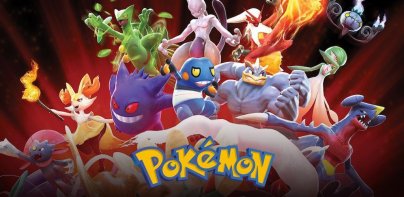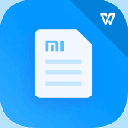


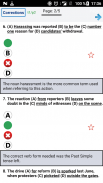
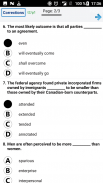
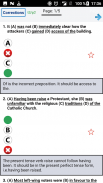
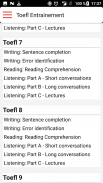
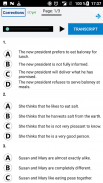
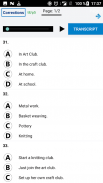
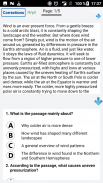
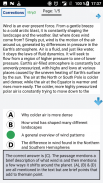
25 Simulator – TOEFL® Test


Descrizione di 25 Simulator – TOEFL® Test
TOEFL is a registered trademark of Educational Testing Service (ETS) in the United States and other countries. This app is not approved or endorsed by ETS.
This application provides you with 12 full tests ITP and 10 Reading part tests for a total of more than 2400 questions so you can conveniently prepare your TOEFL with corrections.
Listening : Part A - Short conversations:
On The Application: You will hear 3 audios of short conversations, each with 10 corresponding questions. You need to select the best response for each question.
On Exam Day: You will hear 3 audios of short conversations, each with 10 corresponding questions. You need to select the best response for each question.
The conversations are usually academic subjects and are between a student and a professor or a university employee.
Tip: Respond to all questions, as you are not penalized for guessing. Even if you're not sure, there's a chance you'll select the correct answer.
Part B - Long conversations:
On The Application: You will hear two audios with 4 questions each. You will need to choose the best response.
On Exam Day: You will hear two audios with 4 questions each. You will need to choose the best response. The conversations will only be played one time. You are not allowed to take notes. The subjects are usually academic, and the main speaker will be an instructor or a professor. The other participants are students who ask or respond to questions.
Tip: A good way to prepare is to listen to videos or films in English to familiarize yourself with different accents and to practice listening in English.
Part C - Lectures:
On The Application: This part consists of 3 or 4 audios and 12 questions in total. You will need to choose the best answer.
On Exam Day: This part consists of 3 or 4 audios and 12 questions in total. You will need to choose the best answer. The narrator will introduce the monologue with a simple sentence (ex. "Listen to this instructor speaking to his class about a TV program"). The conversation will not be repeated.
Tip: Make sure to know the "main point," as this is a frequently asked question. The following questions will be more specific.
Reading : Reading comprehension:
On The Application: The Reading section consists of 50 questions, usually 10 questions per extract. You will need to choose the best response.
On Exam Day: You will need to read several academic texts, each with corresponding questions. You will fill in the correct answer (A, B, C, D) on your answer sheet. In this section, you can manage your time the way you want. You are not constrained by audio recordings like in the Listening section.
Tip: Read between the lines! In these texts, you will find explicit information as well as implicit information. For example, if the characters in the text are opening presents under a decorated fir tree in their living room we can assume it is Christmas morning.
Writing : Part 1 - Sentence completion:
On The Application: Questions 1 to 15 are incomplete sentences. Beneath each sentence you will see four words or phrases, marked A, B, C, and D. Choose the one word or phrase that best completes the sentence.
On Exam Day: Exactly the same as on GlobalExam!
Tip: While reading the sentences, try to think of the type of word that could complete it, and t
Part 2 - Error identification:
On The Application: Questions 16 to 40 consist of sentences that have four underlined words or phrases. The four underlined parts of the sentence are marked A, B, C, and D. Identify the one underlined word or phrase that must be changed in order for the sentence to be correct.
On Exam Day: Exactly the same as on GlobalExam!
Tip: Look out for errors such as conjugation, articles, or prepositions.
TOEFL è un marchio registrato di Educational Testing Service (ETS) negli Stati Uniti e in altri paesi. Questa applicazione non è approvato o approvato da ETS.
Questa applicazione fornisce 12 piena test ITP e 10 di lettura test di parte per un totale di più di 2400 domande in modo si può comodamente preparare il TOEFL con correzioni.
Ascolto: Parte A - conversazioni brevi:
Sulla domanda: Si sente 3 audio di conversazioni brevi, ciascuno con 10 domande corrispondenti. È necessario selezionare la migliore risposta per ogni domanda.
Il giorno di esame: Si sente 3 audio di conversazioni brevi, ciascuno con 10 domande corrispondenti. È necessario selezionare la migliore risposta per ogni domanda.
Le conversazioni sono di solito materie di studio e sono comprese tra uno studente e un professore o un dipendente universitario.
Suggerimento: Rispondere a tutte le domande, in quanto non sono penalizzati per indovinare. Anche se non siete sicuri, c'è una possibilità dovrai selezionare la risposta corretta.
Parte B - conversazioni dalla distanza:
Sull'applicazione: Sentirete due audio con 4 domande ciascuno. Sarà necessario scegliere la migliore risposta.
Il giorno di esame: Si sente due audio con 4 domande ciascuno. Sarà necessario scegliere la migliore risposta. Le conversazioni verranno riprodotti una sola volta. Non è consentito di prendere appunti. I soggetti sono di solito accademico, e il relatore principale sarà un istruttore o un professore. Gli altri partecipanti sono studenti che chiedono o rispondere alle domande.
Suggerimento: Un buon modo per prepararsi è quello di ascoltare i video o film in inglese per familiarizzare con accenti diversi e di praticare l'ascolto in lingua inglese.
Parte C - Lezioni:
Sull'applicazione: Questa parte è composta da 3 o 4 audio e 12 domande in totale. Sarà necessario scegliere la risposta migliore.
Il giorno di esame: Questa parte è composta da 3 o 4 audio e 12 domande in totale. Sarà necessario scegliere la risposta migliore. Il narratore introdurrà il monologo con una semplice frase (es. "Ascoltate questa istruttore che parla alla sua classe di un programma TV"). La conversazione non si ripeterà.
Suggerimento: E 'importante conoscere il "punto principale", come questa è una domanda frequente. Le seguenti domande saranno più specifici.
Reading: comprensione della lettura:
Sull'applicazione: La sezione di lettura è composto da 50 domande, di solito 10 domande per estratto. Sarà necessario scegliere la migliore risposta.
Il giorno di esame: Avrete bisogno di leggere diversi testi accademici, ciascuno con le domande corrispondenti. Potrai compilare la risposta corretta (A, B, C, D) sul foglio delle risposte. In questa sezione, è possibile gestire il vostro tempo nel modo desiderato. Non sono vincolati da registrazioni audio, come nella sezione di ascolto.
Suggerimento: leggere tra le righe! In questi testi, troverete informazioni esplicite, nonché informazioni implicite. Ad esempio, se i caratteri nel testo stanno aprendo i regali sotto un albero di abete decorato nel loro salotto possiamo assumere è la mattina di Natale.
Scrittura: Parte 1 - il completamento della frase:
Sull'applicazione: domande da 1 a 15 sono frasi incomplete. Sotto ogni frase si vedrà quattro parole o frasi, denominate A, B, C, e D. scegliere quella parola o frase che meglio completa la frase.
Il giorno di esame: Esattamente come su GlobalExam!
Suggerimento: Durante la lettura delle frasi, provate a pensare al tipo di parola che potrebbe completarlo, e t
Parte 2 - Identificazione di errore:
Sulla domanda: domande 16 a 40 sono costituiti da frasi che hanno quattro parole sottolineate o frasi. Le quattro parti sottolineate della frase sono contrassegnate con A, B, C, e D. Identificare una parola sottolineata o frase che deve essere cambiata in modo che la frase corretta.
Il giorno di esame: Esattamente come su GlobalExam!
Suggerimento: Guardare fuori per errori come coniugazione, articoli, o preposizioni.








